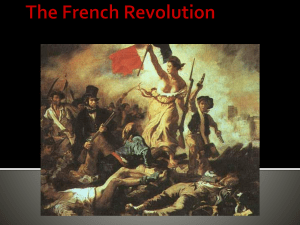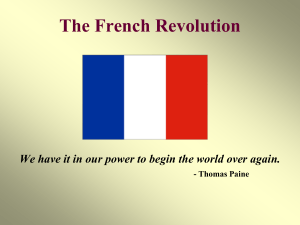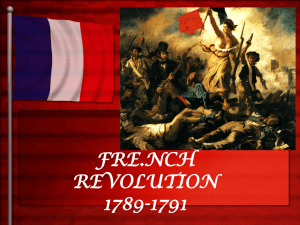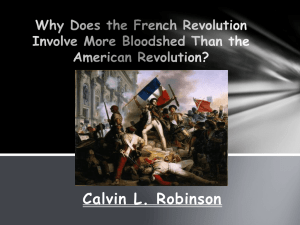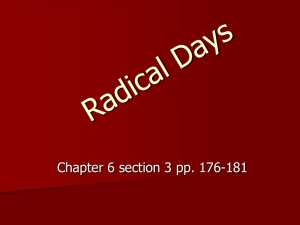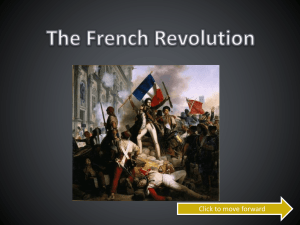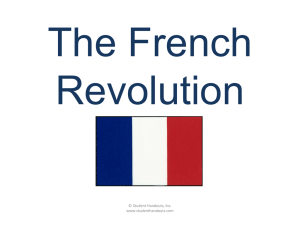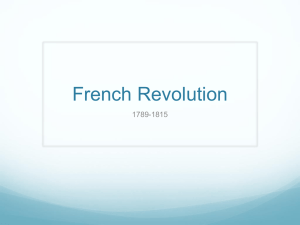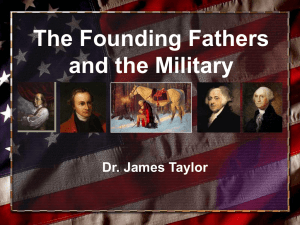Power Point Drill 18
advertisement
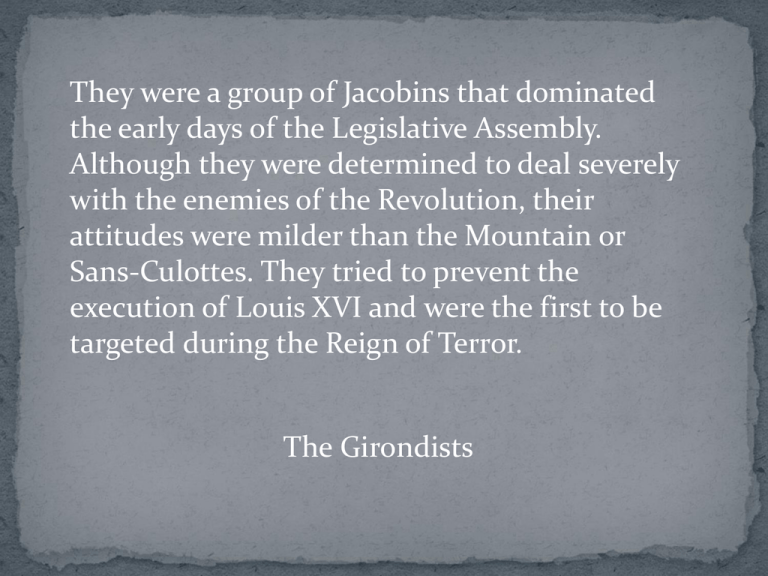
They were a group of Jacobins that dominated the early days of the Legislative Assembly. Although they were determined to deal severely with the enemies of the Revolution, their attitudes were milder than the Mountain or Sans-Culottes. They tried to prevent the execution of Louis XVI and were the first to be targeted during the Reign of Terror. The Girondists They were bonds issued as collateral for confiscated church lands when the Assembly decided on November 2nd, 1789 to finance France’s enormous debt by confiscating the property of the Roman Catholic Church and sell the land to pay the debt. Assignats She was the wife of Louis XVI and the daughter of the Austrian Empress Maria Theresa. Initially popular in France, she became “that Austrian woman” and was accused of sexual promiscuity and personal extravagance Marie Antoinette He led the Conspiracy of Equals which called for more radical democracy and more equality of property. He and his follower believed that the Revolution was not complete because the rich were still in control; the poor had no real relief and were not represented in the new government. Gracchus Babeuf He was a liberal French aristocrat and a hero of the American Revolution, who was offered command of the National Guard after the storming of the Bastille and it was he who gave the guard a new badge (cockade): the red and blue stripes from the colors of the Parisian coat of arms, separated by the white stripe of the royal flag. The Marquis de Lafayette He was the archbishop of Toulouse and a bitter foe of Charles Alexandre de Calonne, who replaced Calonne as French Minister of Finance. But once in office, he discovered to his horror that the financial situation of France was as bad as Calonne had said and immediately sought a similar land tax. Étienne Loménie de Brienne In 1790, this “Father of Conservatism” published Reflections on the Revolution in France in which he argued that the French Revolution would end disastrously because it was not rational and ignored the complexities of human nature and society. Edmund Burke He replaced Jacques Necker as the French finance minister and immediately proposed a series of reforms to encourage internal trade, lower some taxes, reduce the indirect taxes on the peasants; and at the same time authorize a new land tax that all landowners would have to pay whatever their social status. Charles Alexandre de Calonne This battle (September, 1792) was a huge French victory over the invading Prussians and forced the invaders to withdraw giving the revolutionaries a great moral victory – and allowing the victorious French general, Charles François Dumouriez, to go on the offensive in Belgium (the Austrian Netherlands), rout the Austrian army and occupy the entire country by the beginning of winter. The Battle of Valmy He was an invaluable leader during the dark days of 1792 and had been a member of the Committee of Public Safety before Robespierre joined the group, but was one of Robespierre’s victims when Robespierre turned on his fellow Jacobin republicans. Georges Jacques Danton He was as the most influential of the Émigrés and the younger brother of Louis XVI. He helped to formulate the king’s disastrous plan to flee France in June, 1791. In 1824, he became King Charles X. Count of Artois This constitution replaced the Constitution of 1793 which had never gone into effect. It was a reflection of the Thermidorian determination to reject both constitutional monarchy and radical democracy; and went into effect on August 22 1795. The new constitution created a legislature of two houses: The Council of Elders and the Council of Five-hundred The Constitution of the Year III He was the Prussian king who promised to protect Poland and its reformers but, after Catherine the Great’s armies entered Poland at the invitation of self-serving Polish nobles, he changed his mind and participated with Catherine in the 1793 Second Partition of Poland. Frederick William II He was an English scientist, clergyman, political theorist and radical who is best known the discovery of oxygen and being the founder of Unitarianism. Because of his revolutionary ideas, government inspired mobs drove him out of the country. Joseph Priestly They were the radical wing of the Jacobins and got their name because their seats were high up in the assembly hall; they worked with the Sans-Culottes to win the war and root out the enemies – real or imagined - of the Revolution. The Mountain In 1791, she published a Declaration of the Rights of Woman and the Female Citizen in which she challenged the practice of male authority and the notion of male–female inequality. She demanded that women be regarded as citizens and given the right to own property. She was guillotined during the Reign of Terror. Olympe de Gouges This was a replacement for the Cult of Reason ordered by Maximilien Robespierre in May of 1794 and was a deistic cult that reflected Rousseau’s vision of a civic religion that would create greater public morality. The Cult of the Supreme Being Like the Marquis de Lafayette, he was a veteran of the American Revolution; he was a Polish officer who resisted the 1792 invasion of Poland by Russian forces but was defeated and driven into exile. In 1794, Polish officers rebelled against Russia and he returned only to be defeated and captured Tadeusz Kosciuszko He was the Bourbon King of France who ruled from 1643 to 1715. An adherent to the Divine Right of Kings, he worked hard to create a centralized state and eliminate the remnants of Feudalism. During his reign he sought to dominate Europe and fought three major wars. His reign took France to the pinnacle of its glory and yet he sowed the seeds of its destruction by his foreign wars and lavish spending. Louis XIV This document was intended to be a statement of broad principles that would outline the constitution that the National Constituent Assembly was writing. Its two most powerful ideas were civic equality and popular sovereignty. The Declaration of the Rights of Man and Citizen He was a Swiss banker appointed by Louis XVI to make reforms and increase income. In 1781, he produced a report which implied that the financial situation was not as bad as was thought. He argued that if the monies spent on the American war effort were not factored in, then the budget was actually in the black (i.e., had a surplus). Jacques Necker He was the well-intentioned but weak-willed king of France who could not stop France’s escalation into bankruptcy. In 1789 he called the Estates General and quickly lost control. He was put on trial for treason as Citizen Capet. In spite of Girondist support, he was convicted of conspiring against the liberty of the people, condemned and guillotined on January 31st, 1793. Louis XVI This was a social/political order loosely modeled on Rousseau’s Social Contract, especially the part where he emphasizes that a person ought to sacrifice himself for the better good, in this case the Revolution. And it was in this idea of putting the public good above the individual good that caused the Committee of Public Safety to carry out its policies of terror. The Republic of Virtue He was the British Prime Minister who in the 1790s began to take measures to suppress reform and popular movements. He was even able to have Parliament suspend Writs of Habeas Corpus (which requires a person under arrest to be brought before a judge or into court thus making it impossible to hold a prisoner without sufficient evidence) and making the writing of certain ideas treasonable. William Pitt the Younger This group was formed after the Prussian commander invading Belgium, the Duke of Brunswick, threatened to destroy Paris if the royal family was harmed. In response, the Government of Paris created this unelected political entity – which soon came to dominate the Revolution. The Paris Revolutionary Commune He was the person who most idealized the Republic of Virtue and who became the de-facto dictator of the Committee of Public Safety. He was a shrewd politician and his own man. His name became synonymous with the Reign of Terror. But he overshot himself and he and about eighty of his supporters went to the guillotine. Maximilien Robespierre This was presented to the king at the Estates General which was about to meet at Versailles and it criticized government waste, church taxation and the hunting rights of the aristocracy - and also called for regular meetings of the Estates General, fair taxation, more local authority in government and a free press. The Cahiers de Doléances (or list of grievances) This 1791 law forbade the formation of workers associations because the Assembly saw the efforts of the workers to organize as an attempt to reassert the old medieval guilds and thus to oppose the new and revolutionary values of political and social individualism. The Chapelier Law He was appointed Chancellor of France in 1770 by Louis XV. He abolished the Parlements, exiled their members to different parts of France, taxed the aristocrats and made the government more efficient. His efforts collapsed when Louis XV suddenly died in 1774 and Louis XVI dismissed him and attempted to regain the favor of the aristocrats. Rene Maupeou This blunder was a law passed by the National Constituent Assembly on July 12 1790. Its goal was to subordinate the Roman Catholic Church in France to the French government. It also provided for the election of parish pastors and bishops who became salaried employees of the state. The Civil Constitution of the Clergy This was the executive body of the legislature created by the Constitution of the Year III. It was a five person _______________chosen by the Council of Elders from a list submitted by the Council of Five Hundred. Directory He was a priest, political writer and one of the chief political thinkers of the French Revolution. His 1789 pamphlet, What is the Third Estate?, became the manifesto of the Revolution: Abbé Sieyès This was decreed as the new religion of France by the Convention on November 10th 1793 and set about making churches across France into Temples of Reason. The Cathedral of Notre Dame in Paris saw the largest of these ceremonies when its Christian altar was turned into an Altar to Liberty and an inscription To Philosophy was carved in stone over the cathedral's doors. The Cult of Reason This document was issued by Frederick William II of Prussia and Leopold II of Austria on August 27th, 1791 and was intended to frighten the French revolutionaries and protect Louis XVI and his family. The two monarchs promised to intervene in French affairs to protect the royal family and to preserve the monarchy if any other major European power agreed. The Declaration of Pilnitz These were the names given to the new “states” that replaced the old French provinces. They were approximately equal in size and named after rivers, mountains and other geographical features. They were further subdivided into districts, cantons and communes. Departments This was the process by which the king’s royal council strengthened the Third Estate by allowing it to elect twice as many representatives as the clergy or nobility. Thus the Third Estate could easily dominate the Estates General if voting was done by majority vote rather than by order Doubling the Third They were the upper middle class professionals such as bankers, merchants, doctors and lawyers of the Third Estate. They were capitalist oriented and made up the vast majority of the delegates of the Third Estate who came to Versailles in 1789. The Bourgeoisie They were about 16,000 French aristocrats who fled France and settled in other countries near the French border and became involved in counterrevolutionary activities. Émigrés The Estates General was an assembly that represented the entire French population through groups known as estates. The First Estate consisted of about 100,000 Roman Catholic Clergy The Second Estate consisted of about 400,000 aristocrats The Third Estate consisted of the rest of the population or about 24 million people. He was the pope who reacted harshly to the removal of the Refractory clergy and condemned not only the Civil Constitution of the Clergy but also the Declaration of the Rights of Man and Citizen; he even condemned the French clergy who had signed the oath to support the Civil Constitution of the Clergy, especially bishops who had ordained new, elected clergy. Pius VI This was a result of the rioting that followed the Storming of the Bastille in 1789 and swept through much of the countryside. Peasants, afraid of royal troops being sent to suppress their uprisings and driven by rumors of grain shortages, attacked churches, monasteries and many manor houses (châteaux) destroying many legal records and documents. The Great Fear His own pleasure seeking, and his gifts to the nobility and his favorites, financial scandals like the Mississippi Bubble and the Wars of the Austrian Succession and the Seven Year’s War – and France’s participation in the American Revolution drained France financially - even more than his great grandfather. Louis XV They were the most famous of the clubs of the Third Estate. They were excellent networkers and they established local clubs throughout France. They demanded a republic and the elimination of the monarchy - and as such were among the most radical members of the National Assembly. The Jacobins This system drafted the entire population of France into the war effort directing all economic production for military purposes. Young men became soldiers; middle aged men manufactured arms and weapons for the army; women made tents and bandages or worked in hospitals – even children and the elderly had roles to play. Never before had Europe seen a nation organized so efficiently and the revolutionaries raised an army of more than a million men - larger than any in European history. The Levee en Masse This group was proclaimed in June of 1789 after the National Assembly had achieved a de facto Glorious Revolution to show that the main objective of the newly named assembly was to write a constitution which would be completed in 1791. The National Constituent Assembly He was the author of Common Sense and a supporter of the French Revolution. In 1791, he wrote a book, The Rights of Man, as a criticism of Burke’s book Reflections on the Revolution in France and a defense of revolutionary principles. He argued that the good of the monarch and the good of the people are the same. Thomas Paine They led the August attack on the Tuileries Palace in which the Swiss Guard was massacred and sent gangs of thugs into the prisons in the September Massacres to put on trial and arbitrarily murder over 1,400 victims - and invited the other French cities to follow this example. The Paris Revolutionary Commune This was a period of time from the fall of 1793 to the summer of 1794, when many people – from the nobility to clergy to Bourgeoisie to shop keepers and peasants – were arbitrarily arrested and – in many cases – executed by the guillotine. This ferocity was justified because the revolutionaries believed that the preservation of the Revolution was more important than personal security or property or even people’s lives. The Reign of Terror They were clergy who refused to take an oath to support the Civil Constitution of the Clergy. So in reprisal, the National Constituent Assembly removed them from their clerical functions both sacramental and administrative. The Refractory Clergy They were the common people of Paris. Their name means “without breeches” and referred to the long trousers of working men. They were shopkeepers, artisans, and poor workers. They felt that they had been ignored by the old regime and taken for granted by the wealthy men of the National Assembly. They were angry and knew what they wanted: an end to inflation, food shortages and every form of social inequality. The Sans-Culottes This group was founded in May 1793, by Pauline Léon and Claire Lacombe. Its purpose was to fight the internal enemies of the Revolution. They saw themselves a militant citizens and the filled the galleries of the Convention to hear the debates and cheer their favorite speakers. But as they became more radical – seeking stronger control on food prices, ferreting out food hoarders, street fighting with working market women and demanding they wear the revolutionary cockade – the Jacobins began to fear them. The Society of Republican Women This phenomenon occurred just after the execution of Maximilian Robespierre. The fall of Robespierre might have been just another violent turn of events but it actually had sobering effect on France. The members of the Convention used the Robespierre’s death to reassert their power and within a short time the Reign of Terror came to a close. This phenomenon can be described as a widespread feeling that the Revolution had gone too far and a return to center was necessary. The Thermidorian Reaction This moment in history came about after the National Assembly formed itself but king decided to reassert his authority and announced a “Royal Session” of the Estates General for June 23rd and closed the room where the National Assembly had been meeting. On June 20th, the National Assembly discovered they were locked out and moved to a nearby indoor tennis court where its members took this famous action and not to disband until they had given France a written constitution. The Tennis Court Oath This event took place as a result of a mutiny of Polish officers ordered to join their forces with the Russian forces. Led by Thaddeus Kosciuszko, they were defeated and the victors (Austria, Prussia and Russia) wiped Poland off the map causing Poland to cease to exist as an independent state for a hundred and twenty three years – until after the First World War. The Third Partition of Poland This was the name given to reprisal attacks on Jacobins and others responsible for the Reign of Terror with little more due process of law than the Reign of Terror had observed. Sometimes the Convention gave its approval; other times gangs of aristocratic or draft dodging youths roamed the streets assaulting Jacobins. The White Terror They were the upper middle class professionals such as bankers, merchants, doctors and lawyers of the Third Estate. Bourgeoisie He said in this manifesto of the Revolution: What is the Third Estate? Everything! What has it been in the political order up till the present? Nothing! What does it ask? To become something! Abbé Siéyès This occurred when Louis XVI hesitated in ratifying the Declaration of the Rights of Man and Citizen causing many people to believe that he might try to regain his power and because of the scarcity of bread and inflated prices. Its participants “forced” the king to return to Paris. The Women’s March on Versailles They were bitterly anti-monarchial, strongly republican and even suspicious of representative government. They believed that the people should make the decisions of government. The Sans-Culottes Edmund Burke correctly predicted that the French Revolution would end in tyranny; that is a dictatorship. Some scholars thought he was referring to the Marquis de Lafayette but it would be this young Corsican of minor nobility who would make Burke’s prediction come true. Napoleon Bonaparte

